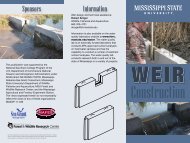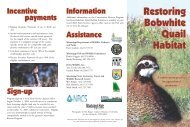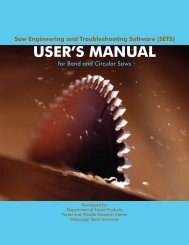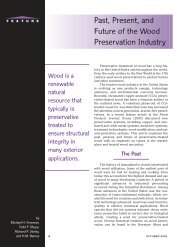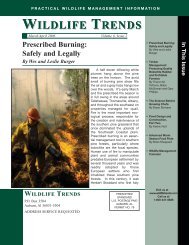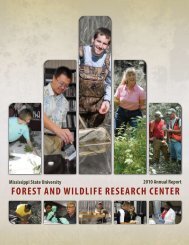Polymeric Betaine as a Wood Preservative - Forest and Wildlife ...
Polymeric Betaine as a Wood Preservative - Forest and Wildlife ...
Polymeric Betaine as a Wood Preservative - Forest and Wildlife ...
You also want an ePaper? Increase the reach of your titles
YUMPU automatically turns print PDFs into web optimized ePapers that Google loves.
IRG/WP 08-30487<br />
THE INTERNATIONAL RESEARCH GROUP ON WOOD PROTECTION<br />
Section 3 <strong>Wood</strong> Protecting Chemicals<br />
<strong>Polymeric</strong> <strong>Betaine</strong> <strong>as</strong> a <strong>Wood</strong> <strong>Preservative</strong><br />
Helmut Härtner, Stefan Schmitt, Futong Cui, <strong>and</strong> H. Michael Barnes*<br />
Rütgers Organics GMBH<br />
Oppauer Straβe 43<br />
D-68305 Mannheim<br />
Germany<br />
*Mississippi State University, <strong>Forest</strong> Products Laboratory, <strong>Forest</strong> & <strong>Wildlife</strong> Research Center,<br />
Box 9820, Mississippi State, MS 39762<br />
Paper prepared for the 2008 IRG Americ<strong>as</strong> Meeting<br />
Playa Flamingo, Guanac<strong>as</strong>te, Costa Rica<br />
November 30 – December 2, 2008<br />
Disclaimer<br />
The opinions expressed in this document are those of the author(s) <strong>and</strong><br />
are not necessarily the opinions or policy of the IRG Organization.<br />
IRG SECRETARIAT<br />
Box 5609<br />
SE-114 86 Stockholm<br />
Sweden<br />
www.irg-wp.com
ABSTRACT<br />
<strong>Polymeric</strong> <strong>Betaine</strong> <strong>as</strong> a <strong>Wood</strong> <strong>Preservative</strong><br />
Helmut Härtner 1 , Stefan Schmitt 1 , Futong Cui 1 , <strong>and</strong> H. Michael Barnes 2<br />
1 Rütgers Organics GMBH, Oppauer Straβe 43, D-68305 Mannheim, Germany<br />
2 Mississippi State University, <strong>Forest</strong> Products Laboratory<br />
<strong>Forest</strong> & <strong>Wildlife</strong> Research Center, Box 9820, Mississippi State, MS 39762<br />
Didecyl polyoxyethyl ammonium borate (DPAB), also known <strong>as</strong> <strong>Polymeric</strong> <strong>Betaine</strong>, w<strong>as</strong><br />
developed <strong>as</strong> a co-biocide for chromium-free copper b<strong>as</strong>ed wood preservatives in Europe in<br />
the 1980’s. This paper summarizes the properties of DPAB <strong>as</strong> a wood preservative. Unique<br />
properties related to the betaine nature of DPAB are discussed in terms of the structureproperty<br />
relationship. Physical properties of DPAB treated wood <strong>and</strong> properties of DPAB<br />
formulations are discussed. Unlike many preservative systems which have negative impact<br />
on strength <strong>and</strong> other physical properties of wood composites, it w<strong>as</strong> discovered that DPAB<br />
b<strong>as</strong>ed formulations were especially suitable for treating wood furnish before composite<br />
manufacturing. Typical laboratory <strong>and</strong> field performance data of DPAB formulations are<br />
presented.<br />
Keywords: <strong>Polymeric</strong> <strong>Betaine</strong>, DPAB, quaternary ammonium compounds, AAC, didecyl<br />
bis(hydroxyethyl) ammonium borate, distribution gradient, fixation<br />
1. INTRODUCTION<br />
During the 1980`s a lot of work w<strong>as</strong> done in Europe to introduce new chromium-free water<br />
born products for wood preservation to address environmental concerns. During the<br />
development of wood preservatives, the consideration of environmental impact of new<br />
products h<strong>as</strong> to be an important part of the strategy due to lack of control over the<br />
environmental fate of preservatives if leached during service or from w<strong>as</strong>te wood. For wood<br />
protection in ground contact, all these second generation water born products were b<strong>as</strong>ed on a<br />
copper <strong>and</strong> an organic co-biocide. Suitable organic co-biocides for wood preservatives include<br />
triazoles, <strong>and</strong> quaternary ammonium compounds.<br />
Alkyl ammonium compounds (AAC) have good biological efficacy, acceptable environmental<br />
characteristics, <strong>and</strong> are cost effective. However, AAC’s have some disadvantages <strong>as</strong> wood<br />
preservatives due to surface spotting <strong>and</strong> non-uniform penetration. This w<strong>as</strong> the starting point<br />
of our development with the objective to overcome the disadvantages of AAC´s without loss<br />
of efficacy <strong>and</strong> other desirable properties.<br />
When the details of the performance of quaternary ammonium compounds were analysed, the<br />
excellent activity of DPAB against copper tolerant fungi w<strong>as</strong> discovered (Fig. 1).<br />
1
Highest Threshold Value (kg/m3)<br />
8<br />
7<br />
6<br />
5<br />
4<br />
3<br />
2<br />
1<br />
0<br />
4.72<br />
1.82 1.77<br />
Coniophora puteana Gloeophyllum trabeum<br />
Postia placenta Coriolus versicolor<br />
7.29<br />
5.32 5.32<br />
4.76<br />
Figure 2. Effect of DPAB on the threshold values from EN113 tests <strong>and</strong> soft-rot tests after<br />
leaching.<br />
2<br />
5.77<br />
5.5<br />
5.99<br />
2.82 2.85 2.93 2.87 2.95<br />
None Leaching Evaporation Radiation<br />
Aging Cycle for EN113<br />
Figure 1. EN113 highest thresholds of DPAB for four fungi <strong>and</strong> four aging techniques.<br />
DPAB w<strong>as</strong> found to be synergistic with copper <strong>as</strong> shown in Figure 2. Impralit KDS w<strong>as</strong><br />
designed <strong>as</strong> a heavy duty preservative for pressure treatment for in-ground <strong>and</strong> above-ground<br />
Threshold Value (kg/m3)<br />
14<br />
12<br />
10<br />
8<br />
6<br />
4<br />
2<br />
0<br />
12.2<br />
2.2<br />
12.2<br />
0<br />
2.4<br />
9.5<br />
2.3<br />
9.6<br />
3.8<br />
6.69<br />
Coniophora puteana<br />
Gloeophyllum trabeum<br />
Postia placenta<br />
Coriolus versicolor<br />
Soft rot<br />
1.7 1.7<br />
1.4 1.4<br />
0.9<br />
0.4<br />
10% Cu/1.6% B 10% Cu/5% DPAB 10% Cu/10% DPAB<br />
<strong>Preservative</strong> System
applications b<strong>as</strong>ed on this synergy. Impralit KDS contains copper, DPAB, <strong>and</strong> boric acid.<br />
KDS w<strong>as</strong> commercialized in Europe in 1992. The Impralit KDS-B formulation is identical to<br />
KDS except no additional boric acid is added. KDS-B still h<strong>as</strong> borate <strong>as</strong> counter ion for<br />
DPAB. In recent years other formulations b<strong>as</strong>ed on DPAB h<strong>as</strong> been developed. One of these<br />
formulations is Impralit TSK10 which contains DPAB <strong>and</strong> Fenoxycarb.<br />
2. THE CHEMISTRY OF DPAB<br />
Typical alkyl ammonium compounds are synthesized by reacting an amine <strong>and</strong> an alkylating<br />
agent such <strong>as</strong> alkyl halide, sulfate esters, or carbonate esters. Didecyl polyoxyethyl<br />
ammonium borate (DPAB), or more precisely didecyl bis(hydroxyethyl) ammonium borate,<br />
w<strong>as</strong> synthesized by the reaction of a dialkylamine with ethylene oxide <strong>and</strong> boric acid. The<br />
resulting quaternary ammonium compounds are very stable under alkaline <strong>and</strong> strong acidic<br />
conditions.<br />
DPAB exists <strong>as</strong> a mixture of monomer <strong>and</strong> dimers depending on the concentration, pH, <strong>and</strong><br />
other factors. In the neat form which contains about 60% active DPAB, it exists <strong>as</strong> almost<br />
100% dimer. At typical work solution strength for wood preservation, DPAB h<strong>as</strong> about 70-<br />
80% in the dimer form. The monomer form dominates only at more than 100-1000 fold<br />
dilutions. Solution equilibrium for DPAB is shown in Figure 3.<br />
C 10 H 21<br />
OH -<br />
C H 10 21<br />
CH2CH2O OH HOCH -H C10H 2CH C<br />
2<br />
10H21 21<br />
2O -B OH -<br />
N+ N+<br />
CH2CH2O OCH CH 2 2<br />
Equilibrium<br />
Free Quat + B(OH) 3<br />
C 10 H 21<br />
+H C H<br />
2O 10 21<br />
Figure 3. Equilibrium of <strong>Polymeric</strong> <strong>Betaine</strong> (DPAB) in solution<br />
The existence of DPAB dimers <strong>and</strong> the equilibrium shift between the dimer <strong>and</strong> monomer can<br />
be monitored by using direct infusion electrospray m<strong>as</strong>s spectrometry (Figure 4).<br />
It is well known that typical quaternary ammonium compounds such <strong>as</strong> DDAC <strong>and</strong> ADBAC<br />
have strong interactions with wood components (Jin <strong>and</strong> Preston 1991, Jiang 2008). Because<br />
of this strong interaction, these cationic biocides have a steep distribution ingredient. The<br />
outer layers of the treated wood have much higher concentrations of the biocide than the inner<br />
layers. For some cationics under certain conditions, the center of the treated wood h<strong>as</strong> such<br />
low levels that are below the toxic threshold. On the other h<strong>and</strong>, the strong interaction of<br />
quaternary ammonium compounds with wood also leads to excellent fixation in wood (Jin <strong>and</strong><br />
Preston 1991).<br />
The betaine nature of DPAB presents unique properties <strong>as</strong> a wood preservative. Since DPAB<br />
exists mostly in the betaine dimer form at work solution strength, it does not behave <strong>as</strong> a<br />
typical cationic molecule <strong>and</strong> therefore does not have strong interactions with wood<br />
components during the wood treating process. Upon fixation, however, DPAB behaves <strong>as</strong> a<br />
3<br />
Reactive quat<br />
N+ CH2CH2O -B<br />
OCH2CH2 N+<br />
CH2CH2O OCH CH 2 2<br />
C 10 H 21<br />
C 10 H 21
Figure 4. M<strong>as</strong>s spectrum of DPAB at different dilutions<br />
cationic molecule <strong>and</strong> h<strong>as</strong> excellent fixation properties in the treated wood. It is believed that<br />
the hydroxyl groups of DPAB also allow interaction with wood through hydrogen bonding.<br />
Typical AACs do not have hydroxyl groups <strong>and</strong> their fixation in wood does not involve<br />
hydrogen bonding.<br />
2.1 Distribution gradient of DPAB in treated wood<br />
The distribution gradient of DPAB in treated wood w<strong>as</strong> studied in two separate tests. In the<br />
first test, the concentration of DPAB in Impralit KDS pressure treated SYP 2x4 (39x89 mm)<br />
w<strong>as</strong> analyzed at different depth. As shown in Figure 5, the DPAB h<strong>as</strong> almost flat distribution<br />
similar to that of the copper component of CCA at 6.4 kg/m 3 . The copper component in KDS<br />
h<strong>as</strong> a similar distribution gradient <strong>as</strong> other alkaline copper systems.<br />
In the second study, the concentrations of DPAB <strong>and</strong> copper in the inner <strong>and</strong> outer zones of<br />
five KDS pressure treated 2x2 (39x39 mm) stakes were analyzed. Average DPAB<br />
concentration varied little across the zones while some gradient w<strong>as</strong> noted with the copper<br />
component (Figure 6).<br />
2.2 Fixation <strong>and</strong> leaching of DPAB<br />
As shown in a number of studies, DPAB fixes strongly in wood. In one study, wood treated<br />
with Impralit KDS containing 14 C labeled DPAB w<strong>as</strong> reduced to wood dust <strong>and</strong> the dust w<strong>as</strong><br />
subject to six consecutive steps of extractions (Table 1). DPAB rele<strong>as</strong>ed to the extraction<br />
fluid w<strong>as</strong> quantified by liquid scintillation counting. After the exhaustive extractions, the<br />
remaining solid w<strong>as</strong> combusted <strong>and</strong> the radio carbon quantified.<br />
In the first step, the wood dust w<strong>as</strong> extracted with a mixture of 0.05 M pH 7 phosphate buffer<br />
<strong>and</strong> 0.05 M NaCl in order to remove the DPAB fixed through the ion exchange mechanism.<br />
Surprisingly, only 1.8% DPAB w<strong>as</strong> removed. This may be due to the fact that DPAB<br />
solubility in water is decre<strong>as</strong>ed by the presence of salts, especially di- <strong>and</strong> tri-valent ions.<br />
Although DPAB is freely soluble in water, low concentration of salt can “oil out” DPAB.<br />
4
3.5<br />
3.0<br />
2.5<br />
)<br />
3<br />
/m<br />
g2.0<br />
(k<br />
n<br />
tio<br />
n1.5<br />
te<br />
e<br />
R<br />
1.0<br />
0.5<br />
0.0<br />
0 5 10 15 20 25 30 35 40<br />
Assay depth (mm)<br />
5<br />
KDS 4 kg/m3 (CuO)<br />
KDS 4 kg/m3 (DPAB)<br />
CCA 6.4 kg/m3 (CuO)<br />
Figure 5. Distribution gradient of DPAB <strong>and</strong> copper in KDS-treated southern pine (SYP)<br />
2x4s compared to copper distribution in CCA treated southern pine.<br />
Inner Zone<br />
Outer Zone<br />
1.888<br />
1.728<br />
3.056<br />
4.000<br />
0.0 0.5 1.0 1.5 2.0 2.5 3.0 3.5 4.0<br />
Retention (kg/m3)<br />
DPAB<br />
CuO<br />
Figure 6. Distribution gradient of DPAB <strong>and</strong> CuO in KDS-treated SYP 39x39 mm stakes.
This property of DPAB, though advantageous in some <strong>as</strong>pects, poses formulations challenges.<br />
In the earlier stages of Impralit KDS development, formulation stability w<strong>as</strong> problematic.<br />
This may be responsible for occ<strong>as</strong>ional poor results observed in competitor testing where<br />
samples were taken from un-agitated tanks at treating plants.<br />
In the second step of the harsh extraction series, the solid w<strong>as</strong> incubated with cellul<strong>as</strong>e<br />
enzyme for 48 hours at 37 o C. Only 10.3% DPAB w<strong>as</strong> found in the supernatant.<br />
Table 1. Extraction of DPAB from Impralit KDS treated wood<br />
Procedure Purpose DPAB<br />
removal/recovery<br />
0.05 M pH 7 phosphate buffer + 0.05 M NaCl,<br />
10 min. extraction<br />
Cellul<strong>as</strong>e enzyme, 48 hrs at 37 o C in 0.05 M<br />
sodium acetate buffer<br />
0.05 M Sodium acetate/0.05 M EDTA, 15 hrs<br />
at 70 o C<br />
Ion exchange 1.8%<br />
Breakdown cellulose 10.3%<br />
Dissolve pectin 3.8%<br />
Acetic acid/NaClO2, 4 hrs at 70 o C Breakdown lignin 2.8%<br />
24% KOH, 15 hrs at 25 o C Hemicellulose extraction 27.8%<br />
72% H2SO4, 4 hrs at 25 o C Cellulose hydrolysis 0.4%<br />
Residue combustion Recovering remaining bound<br />
14 C<br />
48.0%<br />
Total recovery 94.8%<br />
A mixture of sodium acetate <strong>and</strong> EDTA used for extracting pectin removed 3.8% DPAB. A<br />
mixture of acetic acid <strong>and</strong> sodium chlorite, suitable for breaking down the lignin fraction of<br />
wood, removed 2.8% DPAB. Extracting the residue with 24% KOH for 15 hours at 25 o C,<br />
designed for the dissolution of hemicelluloses, removed 27.8% of DPAB.<br />
Finally, reacting the residue with 72% sulfuric acid removed 0.4% DPAB. After the six-step<br />
consecutive harsh extraction procedures, 48% radio carbon remained in the final reside.<br />
These results strongly support the excellent fixation of DPAB in the treated wood. It should<br />
be indicated, however, that the extraction procedures in this study were not designed to<br />
completely remove a certain fraction of wood. For example, sulfuric acid <strong>and</strong> other acids<br />
have been used to completely hydrolyze the polysaccharides in wood to prepare acid lignin or<br />
to determine the lignin content. The sulfuric acid treatment in the current study w<strong>as</strong><br />
insufficient to remove all carbohydrates.<br />
3. EFFICACY OF DPAB FORMULATIONS AGAINST DECAY FUNGI<br />
In a seven year fungus cellar test carried out by BAM, Impralit KDS showed excellent<br />
efficacy in comparison with CCA (Fig. 7).<br />
6
100<br />
90<br />
80<br />
)<br />
70<br />
(%<br />
E<br />
O<br />
60<br />
M<br />
l 50<br />
a<br />
u<br />
id 40<br />
s<br />
e<br />
R 30<br />
20<br />
10<br />
0<br />
0.63 kg/m3 KDS 1.25 kg/m3 KDS 2.52 kg/m3 KDS<br />
3.86 kg/m3 KDS 5.03 kg/m3 KDS 1.30 kg/m3 CCA<br />
2.89 kg/m3 CCA 5.79 kg/m3 CCA<br />
0 1 2 3 4 5 6 7 8<br />
7<br />
Years<br />
Figure 7. Residual MOE of fungus cellar stakes in a 7-year test at BAM.<br />
In two separate 10-year field tests in Norway <strong>and</strong> Sweden, KDS showed similar or better<br />
performance than CCA (Figures 8, 9).<br />
4. DPAB AS AN ACTIVE FOR ANTI-SAPSTAIN FORMULATIONS<br />
Forintek Canada Corp. (Now FPInnovations) carried out a 12-month field trial comparing<br />
DPAB with NP-1(Minchin <strong>and</strong> Byrne, 1995). It w<strong>as</strong> concluded that at 210 μg/cm 2 , DPAB<br />
provided satisfactory 12-month protection of green Dougl<strong>as</strong> fir <strong>and</strong> Hem-fir. In comparision,<br />
NP-1 at up to 180 μg/cm 2 retention did not provide satisfactory protection.<br />
In a recent laborotary test in North America, a DPAB b<strong>as</strong>ed formulaiton w<strong>as</strong> found to be 1.5-2<br />
times more effective than a popular commercial product in North America.<br />
In an European field trial, a DPAB b<strong>as</strong>ed formulation w<strong>as</strong> found to be more effective than a<br />
popular commercial formulaiton for the protection of green pine <strong>and</strong> spruce.
100<br />
90<br />
) 80<br />
d<br />
ile<br />
fa 70<br />
=<br />
(0<br />
n<br />
60<br />
itio<br />
d 50<br />
n<br />
o<br />
c 40<br />
f<br />
o<br />
x<br />
e 30<br />
d<br />
In<br />
20<br />
10<br />
0<br />
0 1 2 3 4 5 6 7 8 9 10<br />
Retention (kg/m3 total ai)<br />
Figure 8. Dose response of KDS <strong>and</strong> CCA in a 10-year stake test in Sorkedalen,<br />
Sweden.<br />
100<br />
90<br />
) 80<br />
d<br />
ile<br />
fa 70<br />
=<br />
(0<br />
n<br />
60<br />
itio<br />
d 50<br />
n<br />
o<br />
c 40<br />
f<br />
o<br />
x<br />
e 30<br />
d<br />
In<br />
20<br />
10<br />
0<br />
8<br />
KDS<br />
CCA<br />
0 1 2 3 4 5 6 7 8 9 10<br />
KDS<br />
CCA<br />
Retention (kg/m3 total ai)<br />
Figure 9. Dose response of KDS <strong>and</strong> CCA in a 10-year field test in Simlangsdalen, Norway.
5. EFFICACY OF DPAB FORMULATIONS AGAINST INSECTS<br />
DPAB b<strong>as</strong>ed formulations are efficacious against beetles, termites, <strong>and</strong> other insects <strong>as</strong> shown<br />
by the low toxic threshold values in Tables 2 <strong>and</strong> 3. In the AWPA E-1 laboratory termite test<br />
carried out at Mississippi State University, KDS showed termite repellency.<br />
Table 2. Toxic threshold of Impralit KDS<br />
Organism Toxic Threshold (kg/m 3 )<br />
Hylotrupes bajulus < 0.22<br />
Reticulitermes santonensis < 2.89<br />
M<strong>as</strong>totermes darwiniensis < 1.83<br />
Coptotermes acinaciformis < 1.83<br />
KDS<br />
CCA<br />
Table 3. Toxic threshold of Impralit KDS determined<br />
according to AWPA E-1 test.<br />
6. CORROSION CHARACTERISTICS<br />
Reticulitermes flavipes Coptotermes formosanus<br />
(kg/m 3 ) (kg/m 3 )<br />
Unleached Leached Unleached Leached<br />
2.1 – 3.2 < 2.1 3.2 – 4.3 2.1 – 3.2<br />
< 2.1 < 2.1 4.0 – 6.4 < 2.1<br />
The corrosion characteristics of KDS <strong>and</strong> ACQ treated SYP were compared using a modified<br />
AWPA E-12 method at Mississippi State University. Both ACQ <strong>and</strong> KDS were at 6.4 kg/m 3<br />
retention. The s<strong>and</strong>wich <strong>as</strong>semblies were exposed at 50.5 o C <strong>and</strong> 91% relative humidity for<br />
28 days. After cleaning, the rate of corrosion in mils per year (one mil equals to 0.025 mm)<br />
w<strong>as</strong> calculated b<strong>as</strong>ed on weight loss <strong>and</strong> surface area. As shown in Table 4, KDS treated<br />
wood is less corrosive than the industrial st<strong>and</strong>ard ACQ.<br />
The solution corrosion characteristics of Impralit KDS <strong>and</strong> KDS-B (no additional boric acid)<br />
were evaluated using AWPA E-17. Both KDS formulations are non-corrosive compare to<br />
CCA (Table 5).<br />
9
Treatment<br />
Table 4. Rate of corrosion of Impralit KDS <strong>and</strong> ACQ treated wood<br />
Rate of Corrosion [Mils per year]<br />
C1010 Mild steel 304 Stainless steel Hot-dip galvanized steel<br />
Untreated 2.9 0.1 2.3<br />
ACQ (6.4 kg/m 3 ) 23.0 -0.01 13.9<br />
KDS (6.4 kg/m 3 ) 17.4 0.3 9.4<br />
Table 5. Solution corrosion (1.2% a.i.) of Impralit KDS, KDS-B, <strong>and</strong> CCA<br />
<strong>Preservative</strong> CCA KDS KDS-B<br />
Rate of corrosion (Mils per year) 0.018 0.029 0.012<br />
The low corrosion of KDS treated wood <strong>and</strong> KDS formulations are not surprising since<br />
DPAB can be used <strong>as</strong> corrosion inhibitors for certain applications.<br />
7. DPAB FOR WOOD COMPOSITE PROTECTION<br />
The use of wood composites h<strong>as</strong> been incre<strong>as</strong>ing in the l<strong>as</strong>t 30 years. The use of wood<br />
preservatives for composites h<strong>as</strong> been limited due to a number of re<strong>as</strong>ons. Products such <strong>as</strong><br />
OSB <strong>and</strong> MDF cannot be treated with a waterborne preservative due to swelling. Addition of<br />
preservative during the manufacturing process is problematic due to the negative impact of<br />
most preservative systems on adhesive curing <strong>and</strong> physical properties of the composite<br />
product.<br />
Research at Mississippi State University h<strong>as</strong> revealed that DPAB is an excellent preservative<br />
for composite protection (Kirkpatrick <strong>and</strong> Barnes 2006, Barnes <strong>and</strong> Kirkpatrick 2005).<br />
<strong>Preservative</strong>s were sprayed to dry flakes before board fabrication. The retention of the<br />
different preservative systems w<strong>as</strong> such that they provide adequate termite protection for the<br />
final product.<br />
In the comprehensive study (Kirkpatrick <strong>and</strong> Barnes 2006, Barnes <strong>and</strong> Kirkpatrick 2005), the<br />
physical properties of phenol formaldehyde-bonded OSB treated with various preservative<br />
systems, including two DPAB formulations, were compared. DPAB treated boards have<br />
higher modulus of el<strong>as</strong>ticity (MOE), modulus of rupture (MOR), work to maximum load, <strong>and</strong><br />
work to proportional limit than untreated control. Boards treated with the two DPAB<br />
formulations have similar or less 24-hour linear expansion <strong>and</strong> thickness swelling than<br />
untreated boards. The internal bond (IB) strength of DPAB treated boards w<strong>as</strong> somewhat<br />
lower than untreated control but w<strong>as</strong> significantly higher than other preservatives. The MOE<br />
<strong>and</strong> MOR results are shown in Figure 10.<br />
10
Control<br />
DPAB 1<br />
DPAB 2<br />
ZB<br />
8. CONCLUSIONS<br />
0 5 10 15 20 25 30 35 40<br />
Although DPAB b<strong>as</strong>ed preservatives have been used in Europe for almost 20 years, its use in<br />
the rest of world is limited. This paper h<strong>as</strong> reviewed the unique chemistry <strong>and</strong> properties of<br />
DPAB-treated wood/composites in terms of research <strong>and</strong> new applications. In addition to<br />
heavy duty preservative applications, the performance of DPAB in antisapstain tests deserves<br />
more attention. The unique properties of DPAB <strong>as</strong> a composite preservative would probably<br />
lead to one of the most promising applications for this wood preservative active.<br />
9. LITERATURE CITED<br />
Barnes H M, <strong>and</strong> Kirkpatrick J W (2005): Biocide treatments for composite panels. In: Proceedings, 39 th<br />
International <strong>Wood</strong> Composites Symposium (R. Tichy, V. Yadama, eds.), W<strong>as</strong>hington State University, April 5-<br />
7, 2005, Pullman, WA, p. 225-231..<br />
Jin L <strong>and</strong> Preston A F (1991): The interaction of wood preservatives with lignocellulosic substrates, I.<br />
Quaternary ammonium compounds. Holzforschung 45(6):455-459.<br />
Kirkpatrick J W <strong>and</strong> Barnes H M (2006): Biocide treatments for engineered wood composites using str<strong>and</strong>board<br />
<strong>as</strong> a test platform. In: <strong>Wood</strong> Protection 2006 (H. M. Barnes, ed), <strong>Forest</strong> Products Society, Madison, p. 329-337<br />
Minchin D <strong>and</strong> Byrne A (1995): A 12-month anti-sapstain field test of Impra-BSK, Forintek Report.<br />
Jiang X (2008): Amine oxides for use in wood protection: III. Penetration aids for wood. International Research<br />
Group on <strong>Wood</strong> Protection, Doc. No. IRG/WP 08-30461, 11 pp.<br />
11<br />
MPa<br />
MOR<br />
MOE/100<br />
Figure 10. MOR <strong>and</strong> MOE values of untreated OSB in comparison with ZB (zinc borate) <strong>and</strong><br />
DPAB-treated boards.



